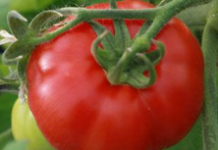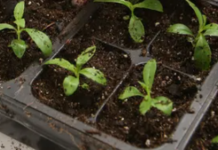By: Christy Dipman
FRUIT
Fertilize Strawberries
Now is the time to fertilize strawberries in order to increase the number of fruit produced next spring. Plenty of daylight and warm temperatures during June, July and August promotes the growth of new runner, or daughter, plants. As daylight hours dwindle and temperatures grow cooler in September and October, fruit buds for the next year’s fruit crop develop. To get a good berry crop next spring, it is important for strawberry plants to be vigorous during this period of fruit bud development.
Nitrogen, applied now, will help promote fruit bud development. A general application rate is ½ to 3/4 pound of actual nitrogen per 100 feet of row. The nitrogen may be in the form of a fertilizer mixture such as ammonium phosphate or 12-12-12, or in a fertilizer containing only nitrogen such as urea or ammonium nitrate. Some specific examples would include:
Iron + (11-0-0) at 6 pounds per 100 feet of row. 12-12-12 at 5.5 pounds per 100 feet of row.
Nitrate of Soda (16-0-0) at 4 pounds per 100 feet of row
Ammonium sulfate (21-0-0) at 3 pounds per 100 feet of row
Urea (46-0-0) at 1.5 pounds per 100 feet of row
On sandy soils, the rate may be increased by about a half.
After spreading the fertilizer, water the area applying at least a half-inch of water to move the nitrogen into the strawberry root areas.
(Ward Upham)
Storing Apples
You can enjoy apples from January to June – with the right conditions. Some apple cultivars can be stored for longer periods than others. Some cultivars will stay in firm, crisp condition for about 6 to
8 months with good storage conditions. The approximate length of time cultivars will keep well under refrigerated conditions are as follows:
Wealthy: 60 days
Paulared: 90 days
Gala: 120 days
Jonathan: 120 days
Grimes Golden: 120 days
Golden Delicious: 150 days
Empire:150 days
Delicious: 160 days
Braeburn: 180 days
Idared: 200 days
Rome Beauty: 220 days
Winesap: 220 days
Fuji: 240 days
Granny Smith: 240 days
Arkansas Black: 240 days
The condition of the apples and how they are stored will strongly influence the storage period.
Some guidelines to help assure good quality and maximum storage life of apples include:
* Store only the best quality.
* Pick as they are first maturing.
* Avoid skin breaks, disease or insect damage, and bruises on individual fruit
* Store in a plastic bag to help retain moisture in the apples. The bag should have a few small holes for air exchange. The bags of apples may be stored in boxes to prevent bruising if they must be stacked or moved from time to time.
* Refrigerate at about 35 degrees F. An extra refrigerator works well.
*Sort about every 30 to 40 days to remove fruit that may be beginning to rot. (Ward
Upham)
VEGETABLES
Asparagus and Rhubarb in the Autumn Season
Harvest is long past but now is the time asparagus and rhubarb plants build up needed reserves for the next year. Be sure to water during dry weather and keep plants free of weeds. Do not fertilize until mid-March next year.
Foliage should be left until all green is gone. It can then be removed or left for the winter to help collect snow. (Ward Upham)
ORNAMENTALS
Tree ID
If you need a simple tree identification key, consider the “What Tree is That?” from the Arbor Day Foundation. Even though it is a bit over 150 pages, the booklet is small enough to fit in your pocket, yet covers many of the trees found in Kansas. The guide uses a step-by-step approach for identification that is perfect for those who are unfamiliar with the technical names of plant parts. Full color botanical illustrations are also helpful. More information can be found at http://www.arborday.org/trees/whatTree/ (Ward Upham)
Mycosphaerella Leaf Spot on Ash
With all the concern about Emerald Ash Borer (EAB), many people may assume that any ash tree with problems is being attacked by EAB.
However, EAB has only been confirmed in Atchison, Doniphan, Douglas, Jefferson, Johnson, Leavenworth, Shawnee & Wyandotte counties. One of the other problems we see with ash is Mycosphaerella Leaf Spot. Though this disease looks serious, it is not.
Mycosphaerella Leaf Spot causes small, brown spots that enlarge to become blotches and may result in early leaf drop. This disease can be severe enough to cause complete defoliation of the tree. However, defoliation this late in the growing season will not hurt the health of the tree. Therefore, because this disease appears sporadically and tree health is not harmed, we do not recommend treatment. Furthermore, treatment would have to be preventative and applied before the disease had infected the leaves. Applying a fungicide now would have no effect.
(Ward Upham)
FLOWERS
Reblooming Christmas and Thanksgiving Cacti
Christmas Cactus (Schlumbergera bridgesii) and Thanksgiving Cactus (Schlumbergera truncate) are popular flowering holiday plants. Both are epiphytes native to the jungles of South America. Epiphytic plants grow on other plants and use them for support but not for nutrients. Though these cacti are different species, they will hybridize and produce varying stem shapes. Christmas cactus normally has smooth stem segments.
Thanksgiving Cactus has hook-like appendages on each segment.
Flowering will not occur unless induced by temperature and light treatment. If the temperature is held at 50 to 55 degrees F, flowering will occur regardless of day length. But flowering usually is not uniform. Temperatures below 50 degrees F prevent flowering. Nights greater than 12 hours long and temperatures between 59 and 69 degrees also can generate flowers. Twenty-five consecutive long nights is enough for flower initiation. Nights will naturally become greater than 12 hours close to the fall equinox, which is on September 23 this year. A plant receiving natural sunlight but no artificial light during night hours, will have this 25-day requirement met about October 20. Alternatively, plants can be placed in a dark place such as a closet for over 12 hours each day to induce flowering. It takes an additional nine to 10 weeks for flowers to complete development and bloom. Both of these cacti like bright indirect light during the day. Too much sun may cause leaves to turn yellow.
Common household temperatures are fine. Keep soil constantly moist but not waterlogged. These plants seem to flower best if kept a little pot bound. If you need to repot, try waiting until spring. (Ward Upham)
PESTS
Oak Lace Bug
We often associate lace bugs with sycamores and cotoneaster, but oaks can be affected as well. Actually the lace bugs that affect these three plants are separate species. Lace bugs are true bugs and therefore feed by sucking sap through straw-like mouthparts that pierce the leaf. These three species also are similar in appearance due to the lacy quality of the wings that lie flat over the back.
Though lace bugs are found on the bottom of leaves, the symptoms will become apparent on top. Damage appears as a stippling effect from white to yellow spots. From a distance, the oak leaves often appear bronze. Even if you don’t find living specimens, their presence is given away by small, shiny dark spots of excrement on the undersides of leaves.
Lace bugs do not cause significant damage to oaks this late in the season, and control measures are not recommended. (Ward Upham)
MISCELLANEOUS
Harvesting and Roasting Sunflower Seed
Sunflowers are usually ready to be harvested beginning in mid-September and into October. Seed heads can ripen on the plant, but they will need protection from birds. Try covering the heads with a paper sack or cheesecloth once the petals start turning brown. Use a twist tie or rubber band to secure the covering. This will not only help keep birds out but will prevent ripened seeds from dropping out of the head. Check for maturity by looking for the following signs:
– Florets in the brown center of the flower disk should be shriveled.
– Heads should have turned down.
– The backside of the head should be lemon yellow.
The ultimate check, of course, is to pull a few seeds to see if they have turned black with white stripes, the typical color. Empty shells usually indicate a lack of pollination earlier in the year. If heads are to remain uncovered, harvest when a few seeds start turning black and white. The flavor will not be good as when seeds are allowed to ripen on the plants, but fewer seeds will be lost.
Cut the heads and place in a paper sack. Some people prefer to cut the heads with about a foot of stem attached and hang them upside down in a dry, well-ventilated area. A paper bag or cheesecloth can be placed over the heads to prevent seeds from dropping as they dry. Seeds can be easily removed from dry heads by rubbing gently.
Roasting Seeds
Raw, mature seeds may be prepared at home by covering unshelled seeds with salted water (2quarts of water to 1/4 to 2 cup salt). Bring to a boil and simmer 2 hours, or soak in the salt solution overnight.
Drain and dry on absorbent paper.
Put sunflower seeds in a shallow pan in a 300-degree F oven for 30 to 40 minutes or until golden brown, stirring occasionally. Take seeds out of the oven and add 1 teaspoon of melted butter or margarine, or cooking oil per 1 cup of seeds if they are to be eaten immediately. Stir to coat. Put on an absorbent towel. Salt to taste. (Ward Upham)
Contriubtors: Ward Upham, Extension Associate
Division of Horticulture
1712 Claflin, 2021 Throckmorton
Manhattan, KS 66506
(785) 532-6173
For questions or further information, contact: [email protected] OR [email protected] This newsletter is also available on the World Wide Web at:
http://hnr.k-state.edu/extension/info-center/newsletters/index.html
The web version includes color images that illustrate subjects discussed. To subscribe to this newsletter electronically, send an e-mail message to [email protected] or [email protected] listing your e-mail address in the message.



